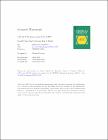| dc.contributor.author | Chew, David | en |
| dc.date.accessioned | 2011-01-10T17:34:41Z | |
| dc.date.available | 2011-01-10T17:34:41Z | |
| dc.date.issued | 2011 | en |
| dc.date.submitted | 2011 | en |
| dc.identifier.citation | Chew, DM, Sylvester, PJ, Tubrett, M, U-Pb and Th-Pb dating of apatite by LA-ICPMS, Chemical Geology, 280, 1-2, 2011, 200-216 | en |
| dc.identifier.other | Y | en |
| dc.identifier.uri | http://hdl.handle.net/2262/48882 | |
| dc.description | PUBLISHED | en |
| dc.description.abstract | Apatite is a common U- and Th-bearing accessory mineral in igneous and metamorphic rocks, and a minor but widespread detrital component in clastic sedimentary rocks. U-Pb and Th-Pb dating of apatite has potential application in sedimentary provenance studies, as it likely represents first cycle detritus compared to the polycyclic behaviour of zircon. However, low U, Th and radiogenic Pb concentrations, elevated common Pb and the lack of a U-Th-Pb apatite standard remain significant challenges in dating apatite by LA-ICPMS, and consequently in developing the chronometer as a provenance tool.
This study has determined U-Pb and Th-Pb ages for seven well known apatite occurrences (Durango, Emerald Lake, Kovdor, Mineville, Mudtank, Otter Lake and Slyudyanka) by LA-ICPMS. Analytical procedures involved rastering a 10?m spot over a 40?40?m square to a depth of 10?m using a Geolas 193nm ArF excimer laser coupled to a Thermo ElementXR single-collector ICPMS. These raster conditions minimized laser-induced inter-element fractionation which was corrected for using the back-calculated intercept of the time-resolved signal. A Tl?U?Bi?Np tracer solution was aspirated with the sample into the plasma to correct for instrument mass bias. External standards (Plesovice and 91500 zircon, NIST SRM 610 and 612 silicate glasses and STDP5 phosphate glass) along with Kovdor apatite were analysed to monitor U-Pb, Th-Pb and Pb-Pb ratios.
Common Pb correction employed the 207Pb method, and also a 208Pb correction method for samples with low Th/U. The 207Pb and 208Pb corrections employed either the initial Pb isotopic composition where known or the Stacey and Kramers model, and propagated conservative uncertainties in the initial Pb isotopic composition. Common Pb correction using the Stacey and Kramers (1975) model employed an initial Pb isotopic composition calculated from either the estimated U-Pb age of the sample or an iterative approach. The age difference between these two methods is typically less than 2%, suggesting that the iterative approach works well for samples where there are no constraints on the initial Pb composition, such as a detrital sample. No 204Pb correction was undertaken because of low 204Pb counts on single collector instruments and 204Pb interference by 204Hg in the argon gas supply.
Age calculations employed between 11 and 33 analyses per sample and used a weighted average of the common Pb-corrected ages, a Tera-Wasserburg Concordia intercept age and a Tera?Wasserburg Concordia intercept age anchored through common Pb. The samples in general yield ages consistent (at the 2? level) with independent estimates of the U-Pb apatite age, which demonstrates the suitability of the analytical protocol employed. Weighted mean age uncertainties are as low as 1-2% for U- and / or Th-rich Palaeozoic-Neoproterozoic samples; the uncertainty on the youngest sample, the Cenozoic (31.44 Ma) Durango apatite, ranges from 3.7?7.6% according to the common Pb-correction method employed. The accurate and relatively precise common Pb-corrected ages demonstrate the U-Pb and Th-Pb apatite chronometers are suitable as sedimentary provenance tools. The Kovdor carbonatite apatite is recommended as a potential U-Pb and Th-Pb apatite standard as it yields precise and reproducible 207Pb-corrected, 232Th-208Pb, and common Pb-anchored Tera-Wasserburg Concordia intercept ages. | en |
| dc.description.sponsorship | This study was funded by the Ireland ? Newfoundland Partnership and we gratefully
acknowledge their financial support. John Hanchar is thanked for providing the
Kovdor carbonatite, Mineville, Mudtank and Slyudyanka apatite samples. Courtney
Gregory, an anonymous reviewer and editor Roberta Rudnick are thanked for
extremely detailed reviews and suggestions which significantly improved this
manuscript. | en |
| dc.format.extent | 200-216 | en |
| dc.language.iso | en | en |
| dc.relation.ispartofseries | Chemical Geology | en |
| dc.relation.ispartofseries | 280 | en |
| dc.relation.ispartofseries | 1-2 | en |
| dc.rights | Y | en |
| dc.subject | Geology | en |
| dc.subject | U?Pb | en |
| dc.subject | Th?Pb | en |
| dc.title | U-Pb and Th-Pb dating of apatite by LA-ICPMS | en |
| dc.type | Journal Article | en |
| dc.type.supercollection | scholarly_publications | en |
| dc.type.supercollection | refereed_publications | en |
| dc.identifier.peoplefinderurl | http://people.tcd.ie/chewd | en |
| dc.identifier.rssinternalid | 69422 | en |
| dc.identifier.doi | https://doi.org/10.1016/j.chemgeo.2010.11.010 | en |
| dc.subject.TCDTheme | Smart & Sustainable Planet | en |
| dc.identifier.rssuri | http://dx.doi.org/10.1016/j.chemgeo.2010.11.010 | en |
| dc.identifier.orcid_id | 0000-0002-6940-1035 | en |




